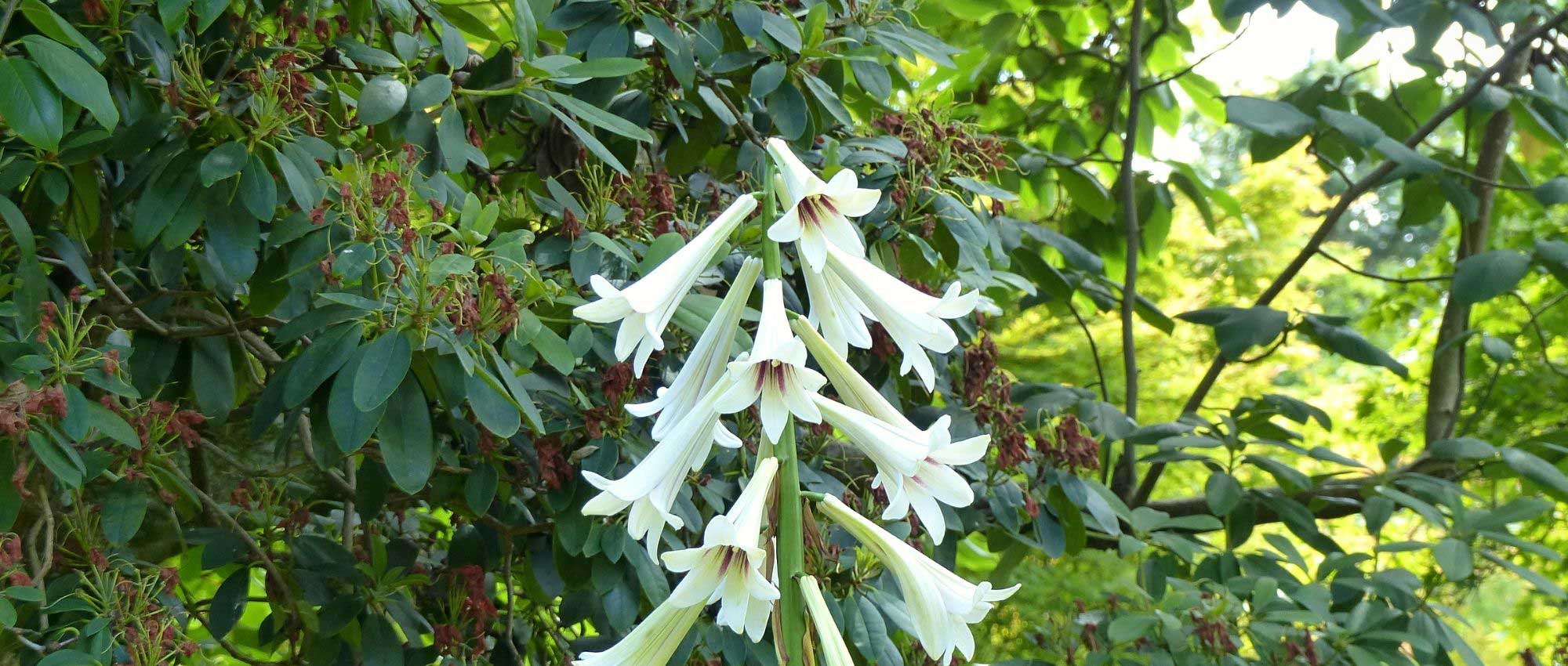
7 rare and unique bulbs
For a garden that stands out from the ordinary!
Contents
There is a great diversity of bulbs for the garden, and some of them are quite rare. Tacca chantrieri, Hippeastrelia, Galtonia, Scadoxus, or Amarcrinum: if these names mean nothing to you, it’s time to discover these bulbs that offer impressive flowerings! Although they are rarely found in gardens, they are not necessarily difficult to grow. However, some of them are not very hardy and need to be brought indoors for the winter, while others can be grown in the open ground even in the north of France. Take advantage of these exceptional bulbs to create a garden with true botanical curiosities.
For more options, discover our entire range of rare bulbs!
Tacca chantrieri 'Green Isle'
Without a doubt the most surprising among the plants we present here, Tacca chantrieri, bat flower or cat’s whiskers, is a lovely bulbous plant native to Asia (Thailand, Myanmar, and China) that offers an impressive flowering! In summer (June-August), the plant produces an upright flower stem, topped with large bracts surrounding a bouquet of dark flowers and very long, trailing green filaments that hang down towards the ground. The variety ‘Green Isle’ is distinguished by its dark green inflorescences, while those of other Tacca chantrieri are much darker, a purplish black. It is a frost-sensitive and quite delicate plant to grow, requiring cultivation in a warm greenhouse, away from direct sunlight.
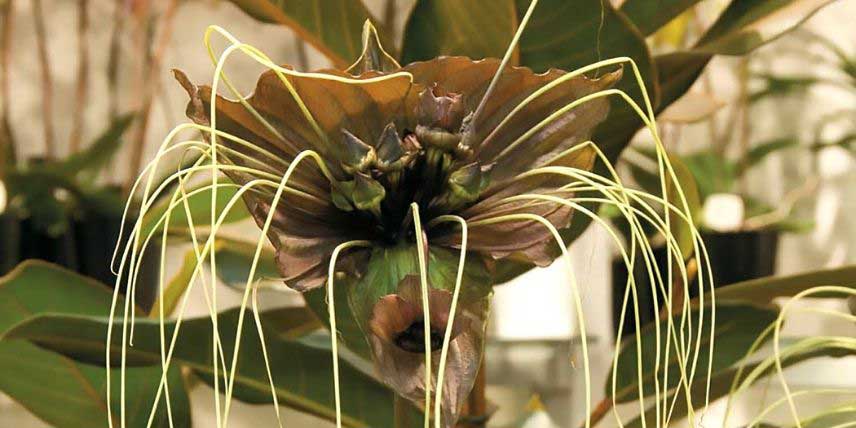
Tacca chantrieri offers surprising flowers that resemble bats! Here, the variety ‘Green Isle’, which produces lighter flowers (brown/green) than the other varieties (purple/black).
Read also
10 summer bulbs to plant in springHippeastrum ‘Durga Pradhan’
Hippeastrelia ‘Durga Pradhan’ is a cross-breeding between Amaryllis (Hippeastrum) and Sprekelia formosissima. It flowers in May-June, producing an upright flower stem that bears one to three large flowers, measuring over 15 cm in diameter. It offers large scarlet red flowers, reminiscent of those of the Amaryllis, but with longer, finer petals. The flowers consist of six large petals surrounding six long stamens. Once it has finished flowering, the foliage dries up and the plant enters dormancy until the beginning of the following spring.
The Hippeastrelia is grown almost like the Amaryllis, but at a different time, as it flowers in spring. Since it is a frost-sensitive plant, it is best to grow it indoors, for example in a conservatory or behind a window. You can eventually take it out onto your terrace from May onwards.

We appreciate the bright scarlet flowers of the Hippeastrelia (photo Mwil)
Discover other Exceptional flowering bulbs
View all →Available in 0 sizes
Available in 1 sizes
Available in 1 sizes
Available in 1 sizes
Available in 1 sizes
Available in 1 sizes
Available in 1 sizes
Available in 1 sizes
Available in 2 sizes
Available in 1 sizes
Galtonia 'Moonbeam'
Galtonia, summer or Cape Hyacinth, is a lovely bulb that produces in summer, usually between June and August, flowering stems adorned with pendulous white flowers, reminiscent of lily of the valley. The variety ‘Moonbeam’ is notable for its double flowers, consisting of several ranks of petals. It is also slightly taller than other varieties, reaching up to 1.10 m in height. Its flowering stems can carry up to 40 flowers.
Plant it in the garden in spring, in fertile, well-drained, slightly acidic soil, and in full sun. We recommend pairing it with other summer-flowering bulbs, such as agapanthus, crocosmias, kniphofias, Crinum, and martagon lilies… Galtonia has the advantage of being relatively hardy: it can withstand temperatures down to -15 °C in dry soil. However, it is better to dig up the bulbs and bring them indoors for winter to protect them from moisture.
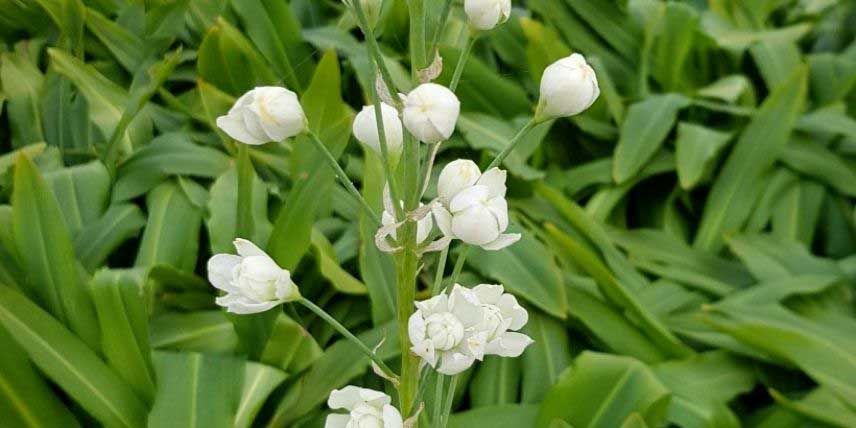
The double white flowers of Galtonia candicans ‘Moonbeam’
Read also
10 bulbous plants with XXL flowersScadoxus multiflorus
Originating from South Africa, Scadoxus multiflorus, also known as Haemanthus multiflorus, is a bulbous plant that produces large, bright red spherical umbel inflorescences. These consist of numerous small flowers, densely grouped, and are borne on a thick, fleshy stem. In our climates, it flowers in summer, usually in July-August, generally before producing leaves. The leaves are large, fairly broad, and sheathing, resembling those of a banana plant. The Scadoxus is a frost-sensitive plant that cannot tolerate negative temperatures, and therefore needs to be grown in a greenhouse (unless you live in a very mild region, such as the Mediterranean coast, where the risk of frost is very low).
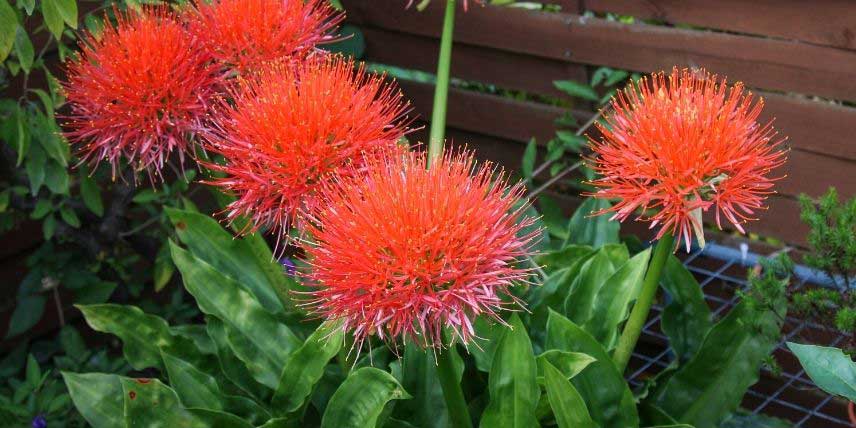
The Scadoxus multiflorus forms large red pom-poms – spherical inflorescences made up of a multitude of small flowers with prominent stamens (photo Maja Dumat)
Eucomis vandermerwei
Unlike other eucomis, Eucomis vandermerwei stands out with its green leaves maculate with small purple spots, and beautifully undulate edges. In addition to this stunning foliage, it produces spikes of purplish-pink flowers in summer, topped with a tuft of leaves reminiscent of pineapples. Its very exotic style is appreciated! However, this eucomis is not very tall, as it does not exceed 20 cm in height. It will look wonderful in a rockery or in a pot. To thrive fully, place it in full sun, in well-draining soil. It can withstand temperatures down to -10 °C in well-drained soil. There is a variety with even more purplish foliage: the Eucomis vandermerwei ‘Octopus’.
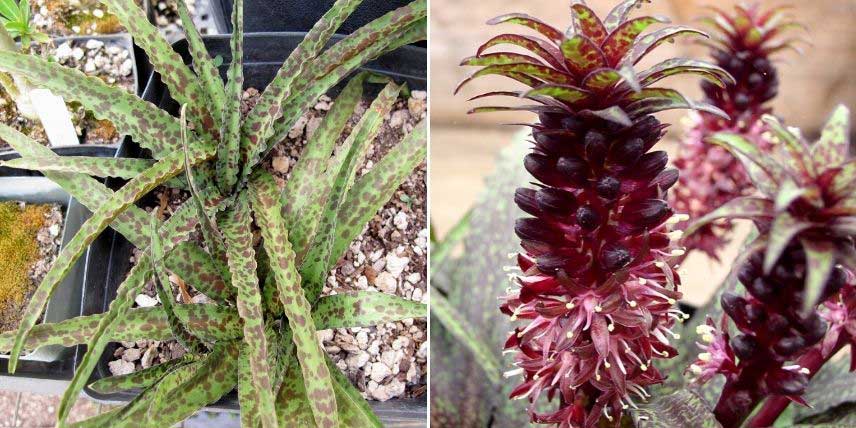
Eucomis vandermerwei has stunning green foliage speckled with purple, with undulate leaf edges. Its purplish-pink flower spikes, topped with a tuft of leaves, are also appreciated. (photos Megan Hansen / Jean-Michel Moullec)
Amarcrinum howardii
Amarcrinum howardii is the result of a cross-breeding between Amaryllis belladona and Crinum moorei. Like its parents, the Amarcrinum produces large flowers made up of six petals, surrounding a bouquet of long stamens. They have a lovely soft pink colour and are pleasantly fragrant! This is a very elegant and romantic flowering. We recommend planting the Amarcrinum in a pot and placing it in a conservatory or indoors in a room that is not too warm, in a bright location. It will then flower between November and December-January.
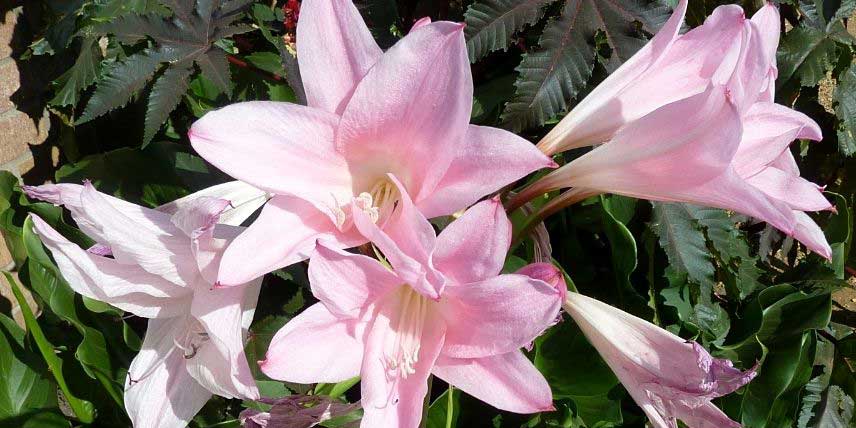
The large soft pink flowers, very elegant, of Amarcrinum howardii (photo Magnus Manske)
Cardiocrinum giganteum
Cardiocrinum, also known as Giant Himalayan Lily, is an impressive bulb! It flowers in summer, in July-August, and produces enormous upright flower spikes that can reach 1.80 m in height! They consist of large trumpet-shaped flowers, white maculate with purple, measuring 15 to 20 cm long. This majestic bulb easily serves as the centrepiece of a border. Feel free to pair it with generously foliaged plants, such as giant hostas, gunnera, or ferns, and other perennials with large flowers. Cardiocrinum is a woodland plant: plant it in shade or partial shade, in cool, humus-rich soil.
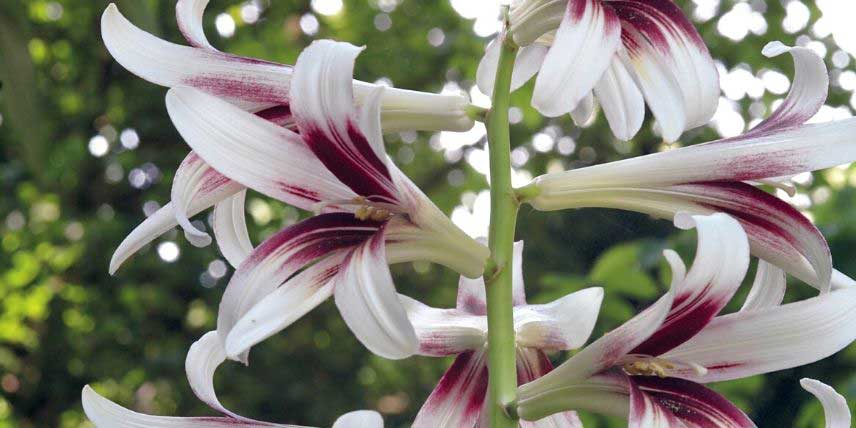
Cardiocrinum offers enormous flower spikes made up of trumpet-shaped flowers, purple-tinged white
- Subscribe!
- Contents
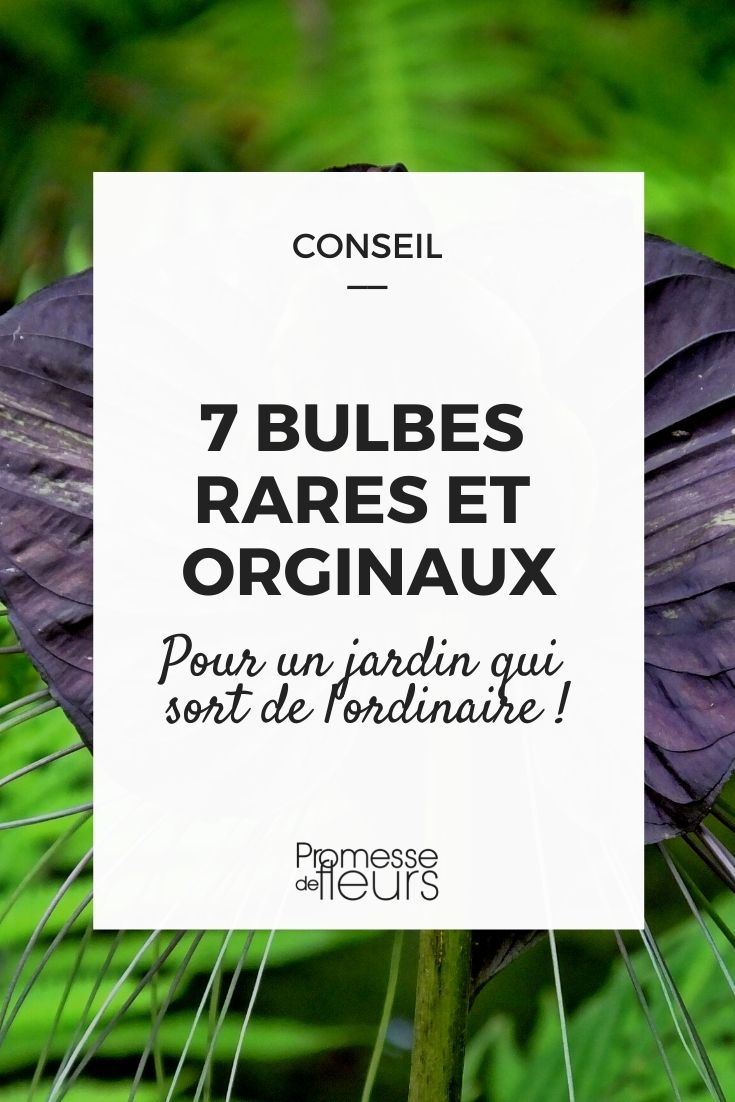































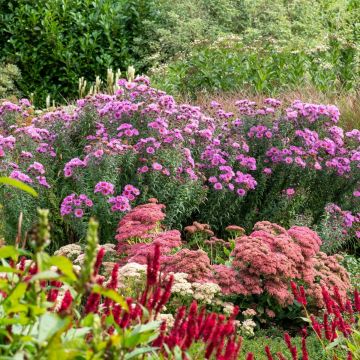
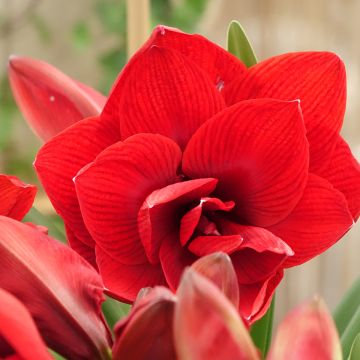

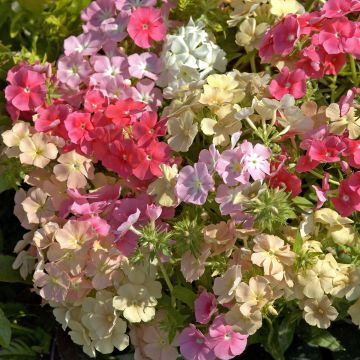
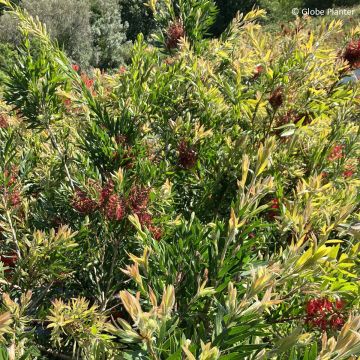
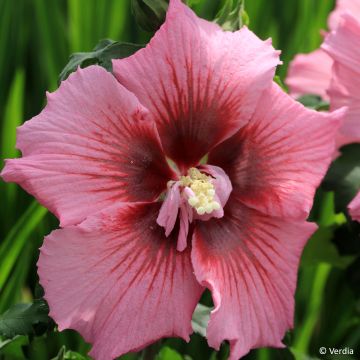
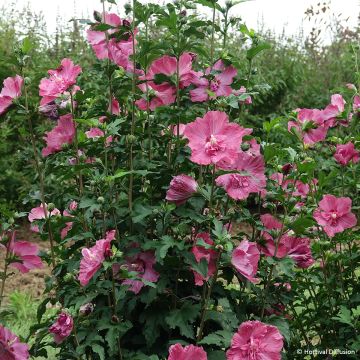
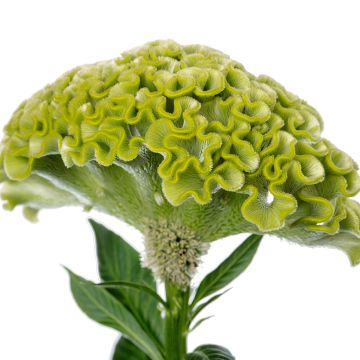
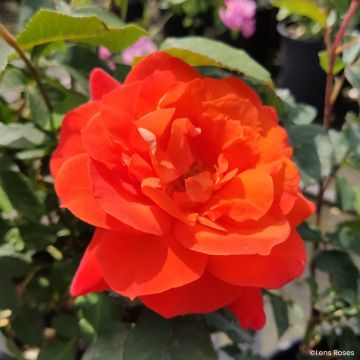
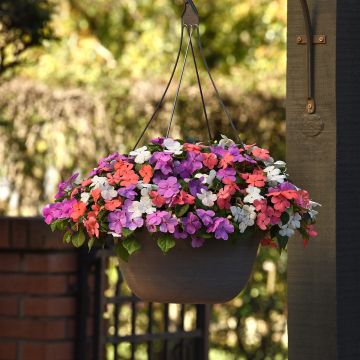
Comments